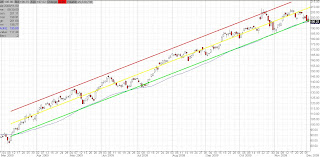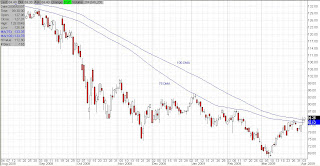

There was a time when our portfolio consisted of nothing other than fertilizer stocks. The pie chart above shows how little we diversify when the going is good. "Cramer, we own MOS, POT, CF and AGU. Are we diversified?"
In July 2008, the fertilizer stocks broke down, and we knew the market was done for. We got out and sat on the sidelines for a few months, eventually scaling into a few Ultralong index positions. We got into these positions a bit too early (never expected the market to drop 60%). Nevertheless, they became profitable, so we continued to hold. We let them go yesterday, putting us back to an all cash position.
Since we sold the fertilizer names back in mid 08, other than index ETF's, we haven't owned another stock since... until now.
We said we would wait for new innovation before investing again. We've found something that's piqued our interest, although granted it's not the next "internet" or "biotech" revolution.
This is a smaller innovation, but the size of its market is phenomenal. It is LED lighting.
Currently, the overwhelming majority of people still buy incandescent bulbs. They've been around for 126 years, so it's a tough habit to break. But this is about to change.
The 2008 energy bill has a section that phases out incandescent lightbulbs for residential applications by 2014. The phase-out begins in 2012. Everyone will be forced to buy CFL's or LED's. CFL's are in the running to replace incandescents, but they are less efficient than LED's, and most of them are not dimmable.
LED lighting has a bright future. But how to capitalize on this information? To do this, you'll need four tools. The first, and most important tool, is patience. This is not a short term trade. LED stocks should be bought and held for about 2 years. The second tool is a basic understanding of fundamental analysis. Right now, these stocks are all overpriced. More on that later. The third tool you'll need are the charts. Being that we'll be investing heavily in LED stocks, we'll be posting charts of the major players in the LED sector on this blog frequently.
The fourth tool you'll need is a basic understanding of the companies that make up this space.
We invite your commentary on which companies are playing "behind the scenes" roles in this technology.
Our understanding of it is that CREE is the largest pureplay in the space. While Philips (PHG) produces LED lighting, as a rule we avoid companies that are not pureplays. The basic concept behind this is that if 4% of a company's business doubles, you're not going to get much out of it. This precludes us from buying AMAT, which is involved in LED technology as well. They've got their hands in so many different businesses that even if they become the leader in LED, their architectural glass division (for example) will mitigate their success. Who needs that?
While CREE is the largest and most visible of the names, it isn't our favorite. We've had better luck in the past betting on the second or third companies because they often have more room to grow. Back when fiberoptics were heating up, we loaded up on SDLI, buying only a small stake in the 800lb gorilla, JDSU. Those of you who've been around long enough to know these names know that JDSU eventually bought SDLI.
You can also do well buying the guys down the chain... the material providers and such. If you look into the LED space, you'll find that Aixtron (AIXG) and Veeco (VECO) are two such names. Our favorite stock in the LED space is AIXG (see its chart above).
Ok, now back to fundamentals:
All of these companies are expected to have excellent earnings growth over the next 5 years. Hence the name, "growth stocks". Naturally, growth stocks come with higher P/E ratios because P/E's are a direct function of growth. As a rule of thumb, a fair value for a growth stock can be calculated by multiplying its annual growth rate by 1.2, then by multiplying that number by its EPS. The number 1.2 is known as a PEG ratio. Warren Buffett's stocks typically have PEG's of approx 1.1 to 1.2. Although your stocks as a growth investor will have higher P/E's than his, you should be content if you're paying the same PEG as he is.
So let's do the math for CREE:
Let's say it will grow by 25% a year for the next 5 years.
25 multiplied by 1.2 equals 30
CREE's current EPS is .79
CREE's EPS next quarter should be .96
30 multiplied by .79 is $23.70
30 multiplied by .96 is $28.80
A fair price for CREE right now would be somewhere around $27
Now let's do the math for AIXG:
Let's say it will grow by 25% a year for the next 5 years.
25 multiplied by 1.2 equals 30
AIXG's current EPS is .32
AIXG's EPS next quarter should be .42
30 multiplied by .32 is $9.60
30 multiplied by .42 is $12.60
A fair price for AIXG right now would be somewhere around $11
------------------
Seeing as how CREE is currently trading at $56 and AIXG is currently trading at $33, it's tough to pull the trigger. Certainly if the market corrects, these "momo" stocks will get hit hard and fast, giving us a great entry point. Then they'll bounce back as quickly as they fell, making new highs long before the market itself.
So do we wait to buy CREE at $27 and AIXG at $11? No. Unless there's another economic meltdown and market panic, you won't be that lucky. Even if these stocks correct, they won't go that low. This is for two reasons. First, corrections take time. By the time the market corrects, we'll be further ahead in their fiscal year, giving them higher EPS's. The above figures would have to be recalculated. Second, the above figures are conservative. What if these companies grow by 30% a year, thereby deserving of a P/E of 36?
You can't be a value investor and a growth investor at the same time. You have to accept that you're going to pay up for growth and popularity if you want to ride the train. But that doesn't mean you have to buy at the very top. Wait for a dip and buy some. Then wait for a broad market correction and buy some more. Scale into your position as the market drops, and as the stock gets reasonably close to a price that you're comfortable paying for it. Then have patience. If you're going to hold it for a couple of years, then you have to believe in it. Your belief in it, according to Peter Lynch, can be a very simple thing. What intrigues us about LED lighting is the sheer number of lightbulbs that need to be replaced over the next 4 years. Basically every light bulb in the world will be replaced. Think about that. Then hold your LED stocks through thick and thin until they become a household name.
We waited to see if LED would catch on before deciding to start scaling into it. The reason is that the growth market is largely a popularity contest. Two companies with identical books can be treated very differently in the same market. Whichever one inspires awe in people will win the race. (Then go to zero, of course.)
We welcome any commentary about LED stocks or our investing methods, as always. If you know of any other new innovation that looks promising, please let us know about it as well.
Let's work together to triple our portfolio values!





































